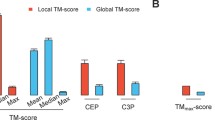Abstract
Structure-based protein classification can be based on the similarities in primary, second or tertiary structures of proteins. A method using virtual-bond-angles series that transformed the protein space configuration into a sequence was used for the classification of three-dimensional structures of proteins. By transforming the main chains formed by Cα atoms of proteins into sequences, the series of virtual-bond-angles corresponding to the tertiary structure of the proteins were constructed. Then a distance-based hierarchical clustering method similar to Ward method was introduced to classify these virtual-bond-angles series of proteins. 200 files of protein structures were selected from Brookheaven protein data bank, and 11 clusters were classified.
Similar content being viewed by others
References
David W M. Bioinformatics: Sequence and Genome Analysis[M]. New York: Cold Spring Harbor Laboratory Press, 2001.
Eisenberg D, Marcotte E M, Xenarios I, et al. Protein function in the post-genomic era[J]. Nature, 2000, 405: 823–826.
TAO Wei-sun, LI Wei, JIANG Yong-ming. Essentials of Protein Molecule[M]. 2nd ed. Beijing: Higher Education Press, 1995. (in Chinese)
Thornton J M, Orengo C A, Todd A E, et al. Protein folds, functions and evolution[J]. J Mol Bio, 1999, 293: 333–342.
Holm L, Sander C. Mapping the protein universe[J]. Science, 1996, 273: 595–602.
Christos A, Ouzounis E, Richard M R, et al. Classification schemes for protein structure and function [J]. Nature Genetic Review, 2003, 4(7): 508–519.
Lo C, Brenner S E, Hubbard T J, et al. SCOP database in 2002: refinements accommodate structural genomics[J]. Nucleic Acids Research, 2002, 30(1): 264–267.
Pearl F M. The CATH database: an extended protein family resource for structural and functional genomics[J]. Nucleic Acids Research, 2003, 31(1): 452–455.
Holm L, Sander C. Touring protein fold space with Dali/FSSP[J]. Nucleic Acids Research, 1998, 26(1): 316–319.
Berman H M, Westbrook J, Feng Z, et al. The protein data bank[J]. Nucleic Acids Research, 2000, 28(1): 235–242.
Lacroix Z, Critchlow T. Bioinformatics: Managing Scientific Data [M]. San Francisco: Morgan Kaufmann Publishers, 2003.
HAO Bai-lin, LIU Ji-xing. Theory Physics and Life Science[M]. Shanghai: Shanghai Science and Technology Press, 1997. (in Chinese)
David J H, Heikki M. Principles of Data Mining[M]. Cambridge: MIT Press, 2001.
Author information
Authors and Affiliations
Corresponding author
Additional information
Foundation item: Project(60371046) supported by the National Natural Science Foundation of China
Rights and permissions
About this article
Cite this article
Li, B., He, Hb., Li, Yb. et al. Tertiary structure-based protein classification by virtual-bond-angles series. J Cent. South Univ. Technol. 12, 465–468 (2005). https://doi.org/10.1007/s11771-005-0183-x
Received:
Accepted:
Published:
Issue Date:
DOI: https://doi.org/10.1007/s11771-005-0183-x




